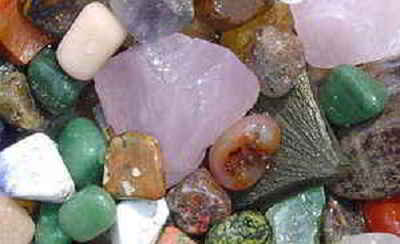

Tennessee Symbols
Tennessee State Gemstone or Gem
Tennessee Pearl

(CaCO3 - Calcium Carbonate)
Adopted in 1979.
The pearl, (CaCO3 - Calcium Carbonate,) taken from mussels in the fresh water rivers of the state, is the official state gem, as designated by 1979 Public Chapter 192 of the 91st General Assembly.
Tennessee river pearls are taken from mussels in the fresh water rivers and come in various shapes and colors. Unlike cultured pearls, which are partially man-made, these pearls are totally made by the mussel. They are 100% natural pearl all the way through. - ("State of Tennessee")
In 2004, the Tennessee River Freshwater Pearl Farm and Museum was designated "the official site of freshwater pearl culturing in the State of Tennessee." The Farm and Museum is located in Camden on Kentucky Lake.
Tennessee Pearl: Tennessee State Gem

Native Americans of the Atlantic Coastal areas and the Mississippi River Basin were the first to collect and use US freshwater mussel pearls and shells. Pearl pendants and ear pendants were worn by both sexes and both pearl and shell were used for decorative purposes on articles of clothing. Some of the tribes used pearls as tributes, reportedly Powhattan (Pocahontas' father) had large stores of pearls received as tribute. These shellfish served as an important supplemental food resource, while the shells themselves were often modified into various tools, such as scrapers and "hoes," bowls and "spoons," and ornaments. Additionally, armlets, pendants, and gaming pieces were made from mussel shell.
During the years between 1882 and 1914, beautiful pearls were taken from many of the state's streams, from the Pigeon and Holston in the east to the Forked Deer and Obion in the west. The Caney Fork in Middle Tennessee was noted for its pearl-bearing mussels, and "pearling" was a favorite sport for young people on Sunday afternoons at the turn of the century.
Natural freshwater pearls are seldom perfectly round or even nearly round, more often than not they are baroque, slugs, or wings. Many pearls, both natural and cultured, have beautiful color and luster. Freshwater pearls are noted for their wide range of color, they can be found in white, silvery white, pink, salmon, red, copper, bronze, brown, lavender, purple, green, blue, cream, and yellow. Although white is the most common color, the most desirable are the pastel pinks, roses, lavenders, and purples. The different colors are a function of the mussel species, genetics, water quality, and the position of the pearl in the shell. Generally, pearls assume the color of the shell in which they form. Problems can arise in putting together matched strands because of the wide range of pastel colors.
Tennessee river pearls are of all colors and they are "natural" as the mussel made them- all pearl, all the way through. They have been found in various shapes- spherical, pear-shaped, and baroque or irregular. After World War I, dams were built on many of the rivers, and the mussels lost their swift and shallow shoals. Also, the waters became more toxic and pearling became unprofitable.
The first experimental US freshwater cultured pearl farm was established in Tennessee by John Latendresse in 1963. Latendresse is the father of
US cultured freshwater pearls, having spent nearly 30 years and more time, money, and effort than anyone else in the research and development of the
industry. Since proving the technology for culturing freshwater pearls in the late 1970's, Mr. Latendresse has established five freshwater pearl farms.
James Peach, who once worked with Latendresse, has established a single farm. Additionally, a single farm has been established in California using
mussels from the Southeastern United States. These farms are the foundation of the US freshwater cultured pearl industry, and the cultured pearl is
the heart and future of the US pearl industry.
Today, pearling exists as a byproduct of shell harvests which supply the cultivated pearl industry of Japan. Tennessee river pearls are among the most
beautiful and durable in the world. At Camden in West Tennessee, these river pearls are collected and crafted into rings, cuff links, stick pins, and
other jewelry. Tennessee River Pearls
JUNE Birthstone: Pearl
June counts three gems as birthstones; pearl, alexandrite, and moonstone.

Historically used an adornment for centuries, the pearl has been recognized as the emblem of modesty, chastity, and purity. The pearl is also associated with the wedding month of June and symbolizes a happy marriage. Unlike most other gemstones, pearls are not mined. The most highly valued pearls are created inside of saltwater oysters and freshwater clams whose shells are lined with mother-of-pearl, or nacre. Pearls from other mollusks lack the desired luster and are considered to be of less value. When a foreign particle enters the mollusk's mantle, shell-secreting cells attach themselves to the particle and form a protective barrier. The process of "pearling"began before 1,000 BC in China and continues today in many freshwater and saltwater areas of the world.
Tennessee Law
The law designating the Tennessee pearl as the official Tennessee state gem is found in the Tennessee Code Annotated, Title 4, Chapter 1, Part 3, Section 4-1-310.
Title 4 State Government
Chapter 1 General Provisions
Part 3 State Symbols
Tenn. Code Ann. § 4-1-310 (2011)
4-1-310. State gem.
(a) The Tennessee pearl is hereby designated as the official state gem. This designation is not intended to prohibit
such activities as dredging, filling, damming or other acts that are otherwise subject to regulation and control by the United States corps of engineers,
the Tennessee Valley authority, or other governmental entities.
(b) The historic Tennessee River Freshwater Pearl Farm and Museum located in Camden, Benton County, Tennessee is hereby
designated the official site of freshwater pearl culturing in the state of Tennessee.
HISTORY: Acts 1979, ch. 192, § 1; T.C.A., § 4-129; Acts 2004, ch. 506, § 1.
Minerals, & Gems

Gemstone, Minerals, Rocks





